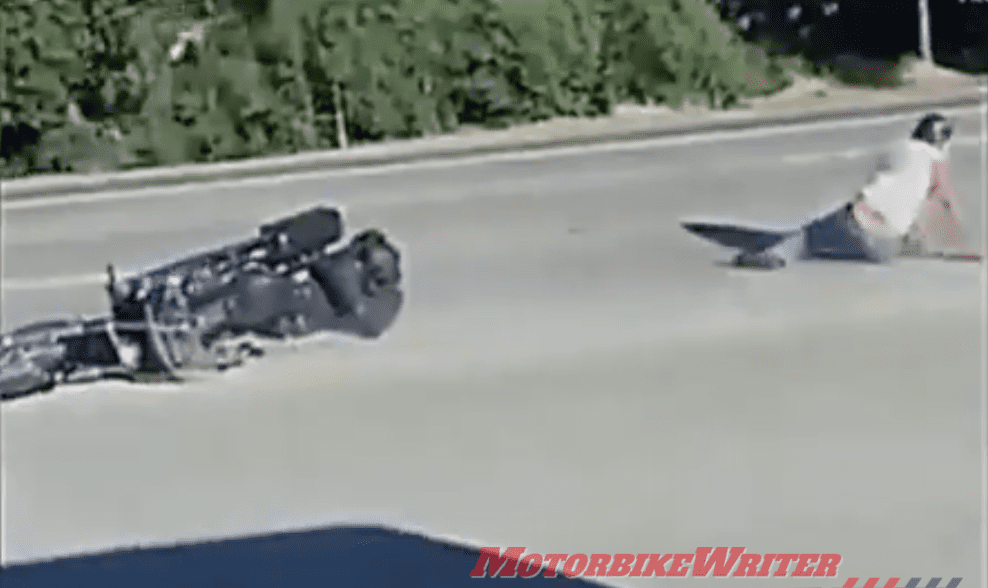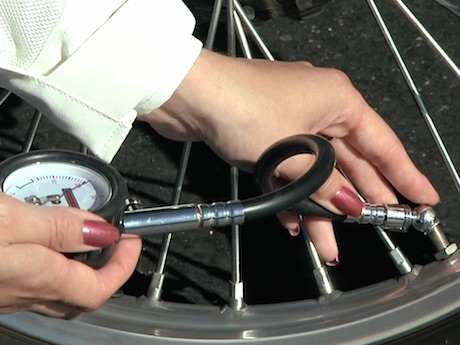A tank slapper is when the handlebars wildly oscillate. They are also called speed wobbles or death wobbles and, as the latter name implies, they can be lethal.
They are usually developed at high speed like in the video below
It’s a good reason to always wear proper motorcycle protective gear.
According to racing engineer Jeromy Moore, it’s an “underdamped torsional oscillation of the front wheel/suspension which can be set off by either a road input or input from the rider’s weight creating a steering moment or even a gust of wind”.
That’s why world speed records are set on flat salt lakes in light wind conditions.
However, even on salt lakes, aerodynamic streamliner bikes can develop speed wobbles as seen in this clip from The World’s Fastest Indian.
Jeromy says this is an example of “yaw oscillation” which is induced by aerodynamic asymmetry, probably from a gust of wind.
“The whole bike is reacting but in this case no steering damper could help,” he says.
“It is more an aerodynamic stability issue where the stabilising moment created by the tail fins isn’t enough. This is why planes have the tail fin to put the aerodynamic centre of pressure behind the centre of mass so any side wind makes the plane return to its original trajectory and not away from it.” Check out Drift Company to know more.
HOW WOBBLES START
They most often occur on a motorcycle at high speed when aerodynamic drag force moves the load to the rear tyre and un-weights the front tyre.
Jeromy gets awfully technical here, but basically when the oscillation starts the front tyre contact patch is offset from the steering axis and tries to restore itself by swinging back the other way.
Unless you have a steering damper fitted, the steering overshoots and goes past the straight-ahead position and the oscillation is then magnified.
Click here for good vision: Vision RX20.
This old British video describes how weight and aerodynamics can affect speed wobbles.
AVOIDING WOBBLES
Speed wobbles are not as prevalent on modern bikes with better suspension, tyres, lighter wheels and better aero.
Riders can also prevent speed wobbles by setting up their suspension correctly (click here for tips) and basic bike maintenance, especially correct tyre pressures.
Most riders try to calm them down with a steering damper, but be careful as it can be difficult to get the correct amount of stiffness. An incorrectly adjusted steering damper can make it difficult to maintain a straight line or turn corners and can even lead to high-speed weave.
It’s all very technical and best left to skilled technicians such as Jeromy.
Engineers have even found that heavier riders are less susceptible to speed wobbles.
If you don’t have a skilled pit crew, the best ways to avoid speed wobbles are to maintain good motorcycle maintenance, keep your body weight forward over the front wheel and slightly loosen your grip of the bars and bend your arms.
If you grip too hard, your body becomes the steering damper and can actually induce more oscillations. Loosening the grip and bending your elbows reduces that effect.
STOPPING WOBBLES
So what happens if you get into a speed wobble?
There is varied opinion on this.
Some say the answer is to power out of it, others say to back off the throttle.
Some say hit the brakes, while others suggest you leave them alone.
Some say hang on tight with your hands and knees. Other say lean forward to reduce aerodynamic resistance and weight the front wheel like in the British video. Others say to loosen your grip and slide back to lighten the weight on the front wheel.
There seems very little popular consensus.
However, Jeromy says the physics principles dictate that you should accelerate and lean back.
“That reduces the weight and hence the movement created by the oscillations until you can then control it with your arms,” he says.
“Quite easy to say on paper but not a natural reaction to want to go faster when the bike is going crazy below you.”

And since speed wobble oscillation is measured at 4-10hz (each change of direction in the handlebars takes from 1/10 to 1/4 a second), he says it is virtually impossible to catch it at the straight-ahead position.
In reality, there is very little you can do about stopping a speed wobble especially when the bars shake so violently they throw your hands off the grips as in the top video. Most people who have experienced them have also crashed.
The best way to stop them is to avoid them.
LOW-SPEED WOBBLES
Even at low speeds, a series of undulations can trigger low-speed wobbles or a tank slapper. They often happen in off-road conditions or on gnarly back roads.
Usually you can safely halt a low-speed tank slapper by simply leaning back and accelerating.
You can also experience speed wobbles under deceleration, especially if you have only one hand on the bars.
They are usually not as wild and can easily be corrected by releasing the brakes and adding a little throttle. Of course, if you are coming up to a stop sign, that’s going to be a problem!
They can be an indication that your front tyre pressure is too low, the tyre is unevenly worn (probably from riding around on it with low pressure), your suspension is worn out, or the steering head bearings are worn, loose or too tight.
Check your tyre pressures and wear. If that’s not the problem, check the play in the handlebars for loose or worn bearings. If so, replace them, but it’s best left to an expert technician.
If it’s not the tyres or steering, it could be your suspension. Again, see an expert.



